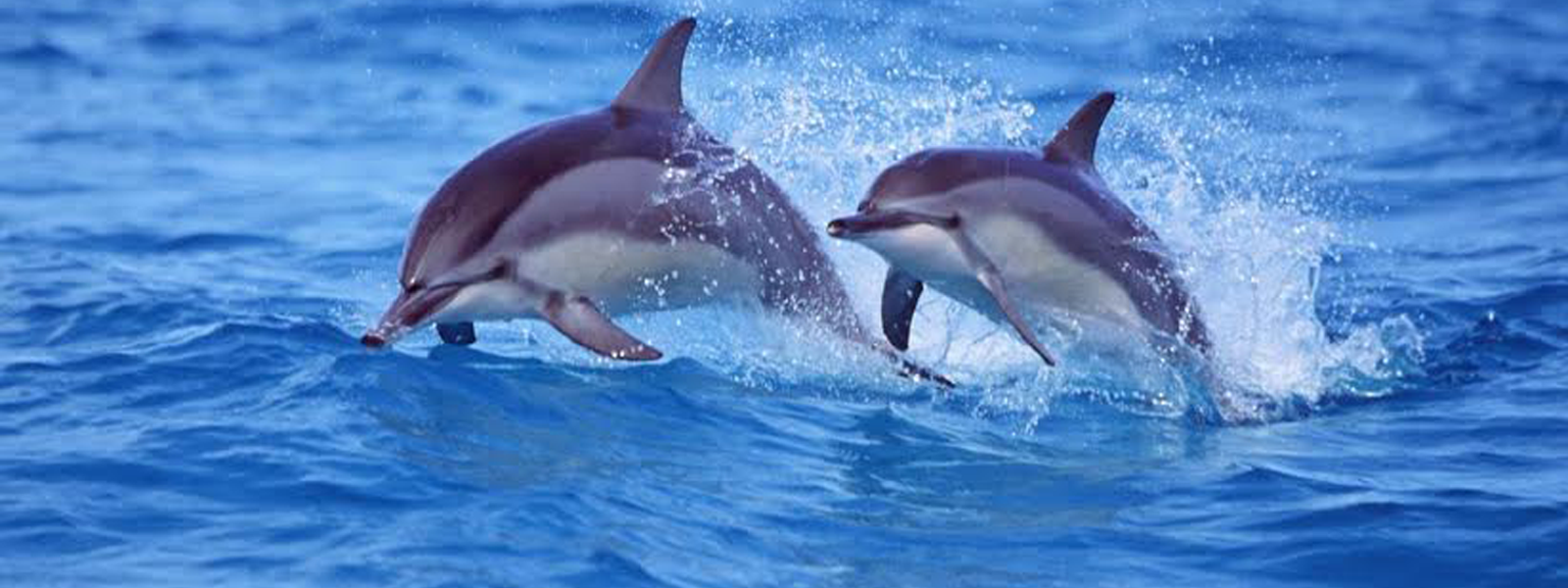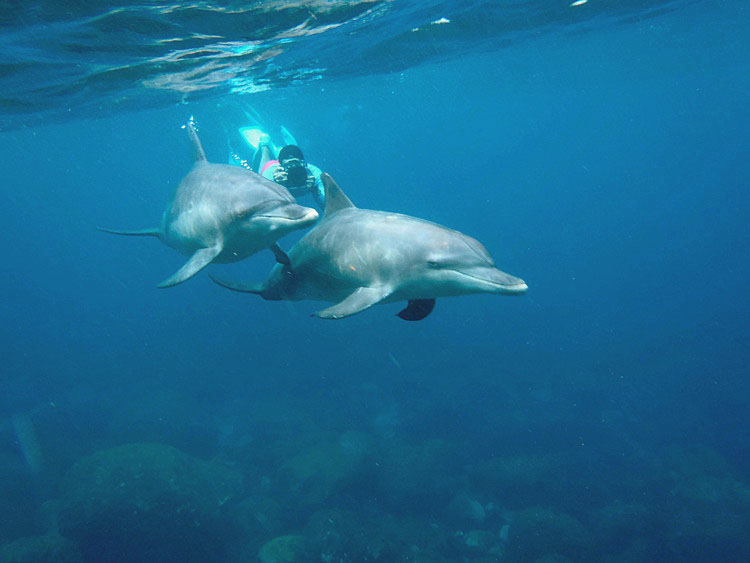

NOTE: For many years, Tomomi Mikawa has been translating letters for us from English to Japanese and vice versa. We asked her if she would like to write blogs for us from a Japanese perspective, and she agreed to do so. Her first blog is about the Fukushima Kids Dolphin Camp, which Earth Island's IMMP helped fund for the 2015. The Japanese language blog follows our English version below.
I am very excited to report on the success of this year’s Fukushima Kids Dolphin Camp (“FKDC”) that took place on Mikura Island, Japan in August. FKDC was started in 2014 by two Japanese gentlemen who aspired to help provide a positive experience to the children of Fukushima whose lives had been adversely affected by the radiation threat after the massive earthquake struck northeastern Japan on March 11, 2011. Though the exact number of children who live under restriction-filled life due to the threat is unknown, nearly two million people reside in Fukushima Prefecture, within 170 km (106 miles) of the Fukushima Dai-Ichi nuclear power plant as of April, 2015.
Mikura Island is a very small island (20.6 km²/ 5,090 ac) located about 200 km (125 miles) south of Tokyo, more than 400 km (250 miles) away from Fukushima. Not many Japanese people know of the island, which may be one of the reasons why the naturalistic beauty of the island is preserved well. There are only 300 or so islanders, most of whom rely on eco-tourism, notably the swim-with-wild-dolphins excursions. Food supplies and household goods are brought in by freight ship weekly and they tend to be scarce. No drug store, restaurant, movie theater, hospital or high school is found on the island. Accommodations are also very limited: there are a total of 8 small inns and 5 bungalows and they become full quickly. During the busy summer season, you have to win a lottery to reserve a room. Everything is within walking distance in this quiet, peaceful village. No camping, pets, or bicycles are allowed for visitors and you have to have a room reservation in order to set your foot on the island.
What makes Mikura so unique, enchanting and even mystical, in my opinion, is its inaccessibility. There are two options to get to the island: you can fly in by helicopter or take the commuter passenger boat from Tokyo spending seven and a half hours aboard overnight, with one stop at a nearby island. Most people choose the latter option as it is less expensive. However, this could be a very tricky bet as it is not uncommon for the boat not to be able to dock at the island’s only pier, a tiny one, when weather is not favorable (i.e., windy). The daily trip is often canceled or the boat is diverted to another island without dropping off passengers. I once heard that it took one islander more than 50 hours to return to her home from the mainland as her boat had to make two round trips between Mikura, Tokyo and other islands, before passengers could finally get off board on Mikura. The islanders hop up or get off the boat very swiftly knowing well that the boat can drift away from the pier anytime.
For the aforementioned reasons, a trip to Mikura could be a very challenging and unpredictable one, even for seasoned travelers who speak the local language. It certainly requires careful advance planning, flexibility, and much luck, but it is great for adventure seekers.
With that said, I would like to share an interview with Tetsuo Nakahara, co-director of FKDC, which was conducted in Japanese.
Tomomi: I remember how thrilling it was to step onto Mikura four years ago as it had taken me two attempts over a year before I could finally visit the island. Are conditions pretty much the same nowadays and did your group encounter similar difficulty?
Tetsuo: Yes, it’s still the same!! We didn’t know until the last minute whether the weather was going to permit us to arrive on the island safely or as scheduled. We had to come up with contingency plans in case we were left stranded in Tokyo, stuck aboard or on the island, etc. Thankfully, it all went well this year. We were very lucky because a typhoon hit hard only two days after our camp ended.
Tomomi: That is so great to hear! You guys must have been protected. By the way, what made you start this initiative? What was the driving force for you and your team members?
Tetsuo: I was a wild dolphin swim guide in Hawaii about 20 years ago. It was enjoyable, but I had reservations about the business side of it. Didn’t feel comfortable using wild dolphins for profit. Fast forward, I was doing some volunteer work for the victims of the earthquake, during which time my friend, a former colleague, Toru Fujita asked me if I would be interested in co-organizing a dolphin camp to help kids. We hit it off right away because I believe in the healing power of nature as well as dolphins, and I thought we could do something meaningful.
Tomomi: I see. How were the 13 campers selected this year? What kind of challenges are these kids faced with?
Tetsuo: We were one of the 40 or so non-governmental organizations from all over Japan that attended a radiation-free retreat fair in Fukushima. These organizations offer various programs either for free or for a fee. The effectiveness of these kinds of “Hoyou” radiation-free wellness programs and camps has been proven ever since the Chernobyl disaster of 1986; that is, the level of radiation in affected people’s bodies has significantly decreased after they spent a certain period of time in a radiation free area.
There were about 200 parents and children who were searching for the right program at the fair. We received 30 applications and we had them submit an essay stating why they want to participate in our dolphin camp. 13 kids --- from 2nd grade to 7th grade; 10 boys and 3 girls --- were carefully selected. That was the maximum number we could take this year, all things considered. All of them had been playing outdoor in Fukushima, but they could not go barefoot, and were very conscious of the radiation level, which remains uncertain. They seemed to be under a fair amount of stress, not having many means to relieve it in a healthy manner.
Tomomi: So, how did the kids behave and respond during the camp? How did dolphins approach them? What do you think they learned?
Tetsuo: All of the campers could encounter and swim with the dolphins of Mikura, which was very exciting. Dolphins are marvelous mammals. More importantly, though, the kids could all feel the power and greatness of nature, being in the open water where they couldn’t stand on their feet, walking on a trail and through a forest, and so on. I believe they could absorb and experience it fully and come to the awareness that they are a part of the nature, the cycle, too. We also witnessed that the kids bonded very well and formed great friendships; they all cried profusely at the end of the camp not wanting to be parted.
Tomomi: That is really heartwarming. I am so glad they were able to swim with the dolphins. Mikura dolphins are very friendly and peaceful, I think, as they live in the shallow waters, in a sheltered environment, away from most predators. I am sure the camp helped broaden the kids’ horizons and they will always remember what they experienced.
What was the biggest challenge for the organizer, by the way? And what were the most surprising part and most touching part for you personally?
Tetsuo: Unlike last year, the kids participated without their parents, so we took extra precautions for ensuring their safety. Not having their parents with them, however, surely fostered their independence and helped them develop more self-reliance as they had to try things on their own and help each other. The most surprising part was that the kids had bad posture and seemed rather slumped at first, but by the end of the camp, they all stood straight and looked perky. What was most moving for me was I got to see how the group became one sharing beautiful moments together. Some kids were moody and acting out a bit at the beginning, but their behavior changed and there was a harmony in the group. They also shared their dreams on the fourth night, which was the last night of the camp, and provided encouragement to one another. That was really great.
Tomomi: That sounds so beautiful. Dreams, hopes, courage, confidence and smiles --- such a precious gift that adults can give to children. Speaking of posture, I saw that kids had a yoga session every morning, and that must have helped, too, in addition to running around freely and playing barefoot outside.
How were they received by the locals?
Tetsuo: They gave us a warm welcome and were all nice to us. You know, kids stand out on the island because there are not that many there.
Tomomi: That’s true. Their community is very small and everyone knows each other. How are the campers from last year doing? Do you guys stay in touch?
Tetsuo: Yes, we do, but we only got to see them once or twice this past year. I am happy that they all seem quite confident.
Tomomi: Wonderful! In order for your team to continue this effort, to make positive changes in the lives of kids in Fukushima for many years to come, what kind of outside support is needed or do you wish to receive?
Tetsuo: First and foremost, the awareness. We would like many people, both children and adults not only in Japan but also from all over the world, to know that there are still many families who need help in the disaster struck areas. We were told that one of the most painful things for them to hear is when others say, “Why don’t you leave Fukushima and move somewhere else?” The amount as well as the effect of radiation is still unknown and these families live in constant fear. Yet, they cannot just leave for various reasons. We want to help alleviate their stress and anxiety through our program. International support is very important now that people’s attention to the affected region has decreased, after four years have passed, which means less funding.
Tomomi: I see... Perhaps, you could have an exchange program collaborating with other organizations outside Japan and invite kids or interns from other countries to join Fukushima kids at your camp in the future? That way, they all can gain some international and cultural experience, too.
Tetsuo: Indeed. It’ll be wonderful if we could connect many kids that way.
Tomomi: Anyway, thank you so much for your time and please keep up the good work.

2015年度 福島キッズドルフィンキャンプ
1984年に旧ソ連で起きたチェルノブイリ原発事故後、被災した子どもたちは政府や国内外の慈善団体の協力により、安全な場所に設けられた保養施設やキャンプ場に送られました。放射能のない場所で一定期間療養することにより、体内の放射能の数値が明らかに下がったそうです。東日本大震災/福島原発事故後の日本でも、転地療養して健康な体を取り戻すための合宿が各地で開催されています。
昨年(2014年)の夏から伊豆七島の一つ、御蔵島(みくらしまhttp://mikura-isle.com/ )で始まった福島キッズドルフィンキャンプ(http://www.kidsdolphincamp.com/ )もそのような「保養プログラム」の一つです。福島の子どもたちを、放射能を気にせずに自然の中で思いっきり遊ばせてあげたい、という願いをもった藤田央(ふじたとおる)さんと中原徹夫(なかはらてつお)さんによって始められました。福島からの電車と船による移動や4泊5日の滞在費を含むキャンプ費用はすべて募金でまかなわれており、子どもたちは無料で参加できるようになっています。
御蔵島は東京の南方200kmにある小さな島で、人口はわずか300人ほどです。徒歩10分で横断できる集落には商店や民宿が数件あるだけで、病院や高校はありません。エコツーリズムを実施しており、観光客がガイドなして山を散策したり、野宿したり、ペットや自転車を持込むことなどが禁じられています。そして事前の宿泊予約がなければ島に上陸することができません。
ほとんどの観光客は、島の周辺に住んでいる140頭ほどの野生のイルカと泳ぐためにこの島を訪れます。豊かな自然と人間が共存している、とても魅力的な島ですが、ほかの伊豆七島や小笠原諸島に比べ、たどり着くのが困難といえます。ヘリコプターもしくは東京の竹芝桟橋から出ている客船で島に入るという2つの手段がありますが、後者については、風が吹いて海が荒れると船が島で唯一の小さな桟橋にドッキングできず、せっかく東京から7時間半かけて旅しても「流されてしまう」というハプニングが生じたりします。そのせいか、島民の方々はすばやく乗船/下船する印象を受けました。なかなか予定通りにはいかないという点で、スリルを求める旅人には最高の旅になる可能性があります。(ちなみに記者は1回目の試みで船が欠航になり、旅行そのものがキャンセル。2回目でやっと島に上陸することができました。ある島民の方は、本土から島に戻るのに東京―御蔵―八丈島間を2往復し、客船内で50時間以上過ごさなければならなかった、とおっしゃっていました。。)
さて、ある意味近いようで遠いような、イルカが棲む魅惑的な御蔵島での保養キャンプの様子を、主催者の一人である中原徹夫さんに伺いました。
Tomomi: 中原さん、私の場合は2年ごしで御蔵島を訪れようと試みたのですが、最初の年は悪天候で船が出港せずお流れになり、翌年やっと島を訪れる機会に恵まれました。それは4年前のことですが、桟橋の状況などは現在も変わってないのでしょうか? 今年のキャンプを決行するにあたり、“無事にたどり着けるか?”という不安はありましたか?
中原: はい、状況は今でも変わっていません。実は、万が一御蔵島にたどり着けなかった場合のシナリオを事前に予測して、東京でキャンプをする、などいろいろな計画を立てていました。幸い今年は天気にも恵まれ、予定通りに終わらせることができました。しかしキャンプから戻って2日後に大型台風が島を直撃したのです。
Tomomi: 無事キャンプを終了できて良かったです。中原さんがこの保養キャンプを始められたきっかけは何ですか?動機を教えていただけますか?
中原: 私は20年ほど前に、ハワイで野生のイルカと泳ぐツアーのガイドをしていました。その際、イルカを使って商売をすることに違和感を覚えました。その後日本に帰国し、東日本大震災後は被災者のためにボランティア活動をしていたのですが、長年の友人である藤田が、“子どもたちを助けるために一緒に保養キャンプをやらないか?”と誘ってきました。自然やイルカの治癒力を信じていたので、すぐに彼と意気投合し、実現に至りました。
Tomomi: 今年のドルフィンキャンプには13人の子どもたちが参加したそうですが、彼らはどのようにして選ばれましたか? そして彼らはどのような困難を抱えていましたか?
中原: 福島で開催される保養プログラムの説明会に参加しました。日本全国から約40団体集まりましたが、すべて政府の支援が入っていない団体でした。我々のキャンプは参加費が無料ですが、中には有料のところもありました。200人くらいの母子さんたちがブースを回っていましたが、我々のキャンプには30人の応募があり、参加志望動機についての作文を提出してもらって男女比や学年などのバランスを考えた末、13人(小学校2年生から中学校1年生までの男子10人と女子3人)に絞らせてもらいました。予算や宿泊施設の規模を考慮すると、今年はその数が限度でした。この子どもたちは全員屋外で遊んではいましたが、裸足にはなれていませんでした。そして常に放射能の数値を気にしているようで、口に出せないようなストレスを抱えていました。
Tomomi: キャンプに参加した子どもたちの様子はどうでしたか?イルカはどんな反応を示していましたか?子どもたちはどんなことを学んでいましたか?
中原: 全ての子どもたちがイルカと泳ぐことができて、とても喜んでいました。イルカは不思議な哺乳類です。イルカに会えたことだけではなく、実際に足のつかない海に勇気を出して入り泳げたことが、子どもたちにとってはとても大きな体験だったと思います。そして森の中を散策したりして、自分たちが大自然のサイクルの一部だということを実感できたと思います。あと、子どもたちは全く知らない者同士だったのに、すっかり仲良くなって、最後別れるときには「帰りたくない」と大泣きしていました。友情の大切さを知ったのですね。
Tomomi: とっても心があたたまりますね。全員イルカと泳げて良かったです。御蔵のイルカたちは、とてもフレンドリーで穏やかな印象があります。だいたい島の周りの浅瀬にいるので、サメなどの外敵から襲われる心配が少ないからかもしれません。今回のキャンプを通して、参加した子どもたちの視野が広がっただろうし、一生心に残る経験になったことでしょう。主催者側にとって一番大変だったことは何ですか?中原さんが一番驚いたことや、感動したことは何ですか?
中原: 去年と違って今年は子どもたちの親が同伴しなかったので、とにかく安全管理に努めました。子どもたちは何でも自分たちで助け合ってやりましたので、彼らの自立心が養われ、自己信頼力が高まったと思います。キャンプの始め、子どもたちの姿勢が悪かったことに驚きましたが、終わりの頃には背筋が伸びて生き生きしていました。気分屋だったり、調子に乗りやすかった子どもたちが、一つになる瞬間を見れたこと、素晴らしい経験を一緒に共有できたことに感動しました。キャンプ最後の晩にはそれぞれが自分の夢を発表して、”絶対叶うよ!”と互いに励ましあっていたシーンにも感動しました。
Tomomi: それは素敵な体験でしたね。夢や希望、勇気や自信、そして笑顔ーーーこれらは大人が子どもたちに与えられる、かけがえのないギフトです。子どもたちの姿勢が目についたそうですが、キャンプ中に毎朝行ったヨガや裸足で自由に駆け回ったことなどが、姿勢の改善につながったのでは? ところで地元の人達は温かく迎えてくれましたか?
中原: はい、とても親切にしてくれました。何せ島にはあまり子どもがいないので、目立ちます。
Tomomi: そうですね。小さいコミュニティーなので、皆さん顔見知りですものね。去年参加した子どもたちは元気にしていますか?連絡は取り合っていますか?
中原: 連絡はとっています。キャンプの後、1,2回会っただけですが、みんな元気で自信に満ちていました。
Tomomi: それは良かった!今後、長期間にわたってこのドルフィンキャンプを継続してゆくために、どのようなサポートが必要ですか?または期待しますか?
中原: まず、日本をはじめ世界中の大人や子どもたちに、現在も助けを必要としている被災者家族がたくさんいらっしゃることを知ってもらいたいです。彼らにとって一番辛いのは、“福島から離れれば良いのに”と言われることだそうです。いろいろな事情があって福島を離れられない方々がたくさんいらっしゃいます。放射能の害については不透明な点があり、多くの方々が不安とストレスを抱えて生活されています。ドルフィンキャンプを通して、こういった方々のサポートをさせて頂きたく思っています。震災から4年以上が過ぎて、日本国内における被災地への関心や支援が減ってしまっている今、海外からの支援がとても重要になっています。
Tomomi: 今後、海外から子どもたちやインターン生を受け入れて一緒にキャンプに参加してもらうことも一つの案ではないでしょうか?自然の中での学びに加えて、国際感覚が身についたり、文化的な交流もできますよね?
中原: そういった形で世界中の子どもたちを結びつけ、繋げるお手伝いができたら良いと思っています。
Tomomi: 今後もこの素晴らしいプログラムとチームの皆さんを応援させていただきます。ご協力ありがとうございました。
(写真提供:中原徹夫)